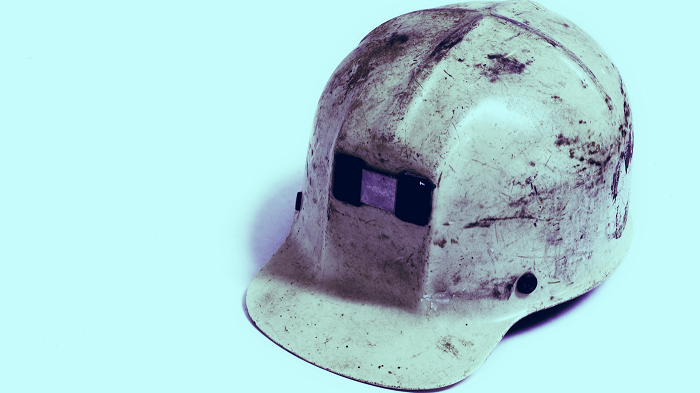This article comes fromdecrypt, original author: Jeff Benson
Odaily Translator |

This article comes from
, original author: Jeff Benson
The upcoming proof-of-stake network will weed out Ethereum miners, but that doesn't mean they'll leave.
Like Bitcoin, the current "mining" of Ethereum (Ethereum) also requires a lot of energy to protect network security, while creating and distributing new digital currencies. Globally, there are also a large number of Ethereum miners, and they also need to buy Valuable miners to solve computational problems and earn ETH, the native cryptocurrency of the Ethereum network. However, if all goes well, Ethereum will undergo a major upgrade in 2022 that will fundamentally change how the network works and how ETH tokens are created — in other words, Ethereum mining will become a thing of the past.
So, what does the future hold for miners mining on the Ethereum blockchain today?
secondary title
"prove"
The Bitcoin white paper was officially released in 2008, which demonstrated a new way to use the concept of cryptography as a decentralized network to securely transfer money, and this concept is now familiar to us: Proof of Work (Proof of Work).
Officially launched in 2015, the Ethereum blockchain uses the same proof-of-work consensus protocol as Bitcoin. In a nutshell, Proof of Work is a method of ensuring that computers agree on the state of transactions and databases at any given time, and under this consensus mechanism, the network is protected from potential double-spend or multiple-spend attacks.
While proof-of-work is a cryptographic algorithm, the Ethereum Foundation explains that "mining itself is 'work,' the act of adding valid blocks to the blockchain." The powerful proof-of-work algorithm consumes a lot of electricity, which has become the main reason for environmental groups to attack cryptocurrencies.
According to Ethereum core developer Tim Beiko, when Ethereum 2.0 is officially launched, the current proof-of-work Ethereum blockchain will be "merged" into the new proof-of-stake blockchain. By the end of 2021 — that is, all mining on the Ethereum network should be shut down by the end of this year. Tim Beiko says:
"Before the Ethereum network is upgraded to 2.0, miners should prepare in advance to ensure that they will not lose money."
But the question is, after the upgrade of Ethereum 2.0, what should the current miners do?
secondary title
"merge"
Michael Carter, a cryptocurrency miner and host of the YouTube crypto channel BitsBeTrippin, does not expect a massive decline in the Ethereum mining market until the Ethereum proof-of-work network and proof-of-stake mining "merge."
But just in case, Michael Carter still put a lot of effort into estimating the profit and profit. They analyzed at least 10 different scenarios to calculate the profitability of Ethereum mining in the next few months, such as high price and high transaction volume, High prices and low volume, etc. Although Michael Carter is a supporter of native Ethereum, he said that he is ready for the upgrade of Ethereum 2.0-"If another chain becomes more profitable, I will switch mining resources to the new chain." superior."
Of course, Michael Carter is not in a hurry to switch networks. For those Ethereum miners with considerable cash flow, they can actually fight the "protracted war" now, that is, continue to hold ETH and wait for the price to rise.
Once Ethereum 1.0 and Ethereum 2.0 are merged, Michael Carter believes that the current Ethereum miners should switch to other blockchains. Now there are two simple choices, one is Ethereum Classic and the other is Ravencoin:
*Ethereum Classic, another chain that emerged from the hard fork of the Ethereum network in 2016, had a market capitalization of approximately $4.7 billion as of June 22.
* Ravencoin is the native asset of the network used to transfer digital assets and tangible assets. As of June 22, Ravencoin's market capitalization is about 436 million US dollars, and the token price is about 0.05 US dollars.
However, in Michael Carter's opinion, the road for miners who use application-specific integrated circuit (ASIC) mining machines to mine in the future may be more difficult, because although ASIC mining machines have more powerful computing power, Ethereum has already used algorithms to take away such miners. Most of the mining advantages of the machine, and once the Ethereum 2.0 upgrade is completed, they cannot switch to other networks to continue mining like GPU miners.
According to a comment from a Reddit user:
“ASIC miners will become useless in the future.”
secondary title
"warn"
Unlike Michael Carter and other miners who are ready to "jump ship" after the Ethereum 2.0 upgrade, not all Ethereum miners are satisfied with the current upgrade arrangement.
This July, the ethereum network will undergo a major update that is expected to bring major changes to how (and how much) miners are paid. This update will include the Ethereum Improvement Proposal EIP-1559 in the so-called "London" hard fork - after the proposal is deployed, the Ethereum blockchain will automatically calculate the amount of gas (Ethereum's network fee) paid by users. , and then... destroy it.
In other words, in the future, ETH transaction fees will no longer be paid to miners, but will be sent to an address that no one can access, and will eventually be burned into ashes... This means that after the "London" hard fork is completed, Ethereum miners only Receive newly minted ETH as a reward. While proponents of EIP-1559 believe that this upgrade will ultimately benefit everyone on the network (since reduced supply increases demand, which in turn can push up ETH prices), not all miners think so — no doubt some Support, there will be condemnation.
EIP-1559 sets the unofficial "game clock" for ethereum network integration, as it also represents the point at which miners are likely to start abandoning the ethereum network (in any case, the ethereum network may abandon after a few months mining). However, if they leave Ethereum now, miners may miss the last chance to "get rich".
Ethereum core developer Tim Beiko explained:
“If miners leave the network before EIP-1559 is deployed to the Ethereum blockchain, then the overall network computing power will be reduced and other miners will get more profits. In other words, the fewer people who mine, the more people who stay The easier it is to get ETH."
Given that Ethereum must carry out distributed "mining" to ensure network security, once a large number of miners leave the network, it may also bring certain risks to the blockchain.
"Before EIP-1559 is deployed to the Ethereum blockchain, we actually need some miners, but if they gradually leave the network before the network upgrade, it may bring security risks to the current network. But in fact, most miners A lot of costs have been invested in infrastructure such as mining machines, considering that miners have already incurred a lot of fixed costs, so they should have an incentive to mine to the last block.”
Although some miners with outdated mining equipment may "hop" as the time for EIP-1559 to be deployed to the Ethereum blockchain gets closer, there will still be miners on the Ethereum network who will stick around. Compass Mining's Will Foxley commented on this phenomenon:
"A lot of people think that the deployment of EIP-1559 to the Ethereum network will cause miners to leave, but at least before the deployment, there are still a lot of miners mining on the Ethereum blockchain, because they want to collect as much as possible before merging. Get ETH because they know that once EIP-1559 is deployed, the price of ETH will go up."
secondary title
are you ready?
Michael Carter emphasized:
“Everyone knows that Ethereum will move to the proof-of-stake consensus algorithm, but only those who are prepared will be able to cope with this change. Some mining pools have been preparing for the change of the Ethereum network for a few years, such as the second Ethereum The large mining pool F2Pool has built an ETH 2.0 validator pool."
Perhaps coincidentally, some mining pools announced support for EIP-1559 as early as the beginning of the year, indicating that there is already a clear understanding in the market that once this Ethereum improvement proposal is deployed, the price of ETH will increase over time.
From past experience, any blockchain network needs to stand with core users and contributors, otherwise it will pay a high price, such as the previous hard fork of The DAO. The good news is that key developers and core contributors have been actively building Ethereum, helping it thrive and develop to where it is today.
However, the Ethereum community also has objections to the EIP-1559 proposal, and SparkPool is one of them. Currently, SparkPool controls nearly a quarter of Ethereum's computing power, and they believe that the EIP-1559 proposal is "the distribution of wealth and the tyranny of the majority." However, Will Foxley of Compass Mining believes that SparkPool's opposition to the deployment of EIP-1559 may not be successful:



